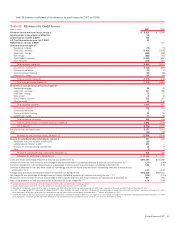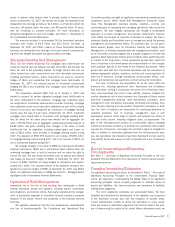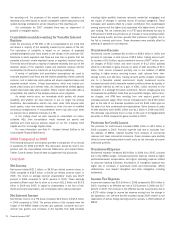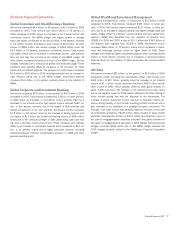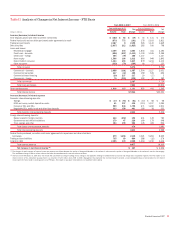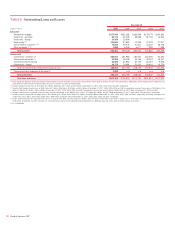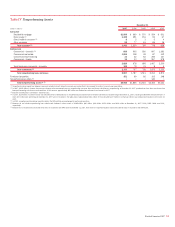Bank of America 2007 Annual Report Download - page 95
Download and view the complete annual report
Please find page 95 of the 2007 Bank of America annual report below. You can navigate through the pages in the report by either clicking on the pages listed below, or by using the keyword search tool below to find specific information within the annual report.prices or interest rates beyond what is already implied in forward yield
curves at December 31, 2007, the pre-tax net losses are expected to be
reclassified into earnings as follows: $1.3 billion, or 19 percent within the
next year, 68 percent within five years, and 89 percent within 10 years,
with the remaining 11 percent thereafter. For more information on
derivatives designated as cash flow hedges, see Note 4 – Derivatives to
the Consolidated Financial Statements.
The amounts included in accumulated OCI for terminated derivative
contracts were losses of $3.8 billion and $3.2 billion, net-of-tax, at
December 31, 2007 and 2006. Losses on these terminated derivative
contracts are reclassified into earnings in the same period or periods dur-
ing which the hedged forecasted transaction affects earnings.
Mortgage Banking Risk Management
IRLCs and the related residential first mortgage loans held-for-sale are
subject to interest rate risk between the date of the IRLC and the date the
loans are sold to the secondary market. To hedge interest rate risk, we
utilize forward loan sale commitments and other derivative instruments
including purchased options. These instruments are used as economic
hedges of IRLCs and residential first mortgage loans held-for-sale. At
December 31, 2007, the notional amount of derivatives economically
hedging the IRLCs and residential first mortgage loans held-for-sale was
$18.6 billion.
The Corporation adopted SFAS 159 as of January 1, 2007 and
elected to account for certain originated mortgage loans held-for-sale at
fair value. Subsequent to the adoption, mortgage loan origination costs
are recognized in noninterest expense when incurred. Previously, mortgage
loan origination costs would have been capitalized as part of the carrying
amount of the loans and recognized as a reduction of mortgage banking
income upon the sale of such loans. At December 31, 2007, residential
mortgage loans held-for-sale in connection with mortgage banking activ-
ities for which the fair value option was elected had an aggregate fair
value of $9.56 billion and an aggregate outstanding principal balance of
$9.82 billion. Net gains resulting from changes in fair value of loans
held-for-sale that we originated, including realized gains and losses on
sale of $333 million, were recorded in mortgage banking income during
2007. The adoption of SFAS 159 resulted in an increase of $256 million
in mortgage banking income during 2007, and in an increase of $212 mil-
lion in noninterest expense during 2007.
We manage changes in the value of MSRs by entering into derivative
financial instruments. MSRs are a nonfinancial asset created when the
underlying mortgage loan is sold to investors and we retain the right to
service the loan. We use certain derivatives such as options and interest
rate swaps as economic hedges of MSRs. At December 31, 2007, the
amount of MSRs identified as being hedged by derivatives was approx-
imately $3.1 billion. The notional amount of the derivative contracts des-
ignated as economic hedges of MSRs at December 31, 2007 was $69.0
billion. For additional information on MSRs see Note 21 – Mortgage Servic-
ing Rights to the Consolidated Financial Statements.
Operational Risk Management
Operational risk is the risk of loss resulting from inadequate or failed
internal processes, people and systems, including system conversions
and integration, and external events. Successful operational risk manage-
ment is particularly important to diversified financial services companies
because of the nature, volume and complexity of the financial services
business.
We approach operational risk from two perspectives: corporate-wide
and line of business-specific. The Compliance and Operational Risk
Committee provides oversight of significant corporate-wide operational and
compliance issues. Within Global Risk Management, Enterprise Opera-
tional Risk Management develops policies, practices, controls and
monitoring tools for assessing and managing operational risks across the
Corporation. We also mitigate operational risk through a broad-based
approach to process management and process improvement. Improve-
ment efforts are focused on reduction of variation in outputs. We have a
dedicated Quality and Productivity team to manage and certify the process
management and improvement efforts. For selected risks, we use speci-
alized support groups, such as Information Security and Supply Chain
Management, to develop corporate-wide risk management practices, such
as an information security program and a supplier program to ensure that
suppliers adopt appropriate policies and procedures when performing work
on behalf of the Corporation. These specialized groups also assist the
lines of business in the development and implementation of risk manage-
ment practices specific to the needs of the individual businesses. These
groups also work with line of business executives and risk executives to
develop appropriate policies, practices, controls and monitoring tools for
each line of business. Through training and communication efforts, com-
pliance and operational risk awareness is driven across the Corporation.
The lines of business are responsible for all the risks within the
business line, including operational risks. Operational and Compliance
Risk executives, working in conjunction with senior line of business execu-
tives, have developed key tools to help identify, measure, mitigate and
monitor operational risk in each business line. Examples of these include
personnel management practices, data reconciliation processes, fraud
management units, transaction processing monitoring and analysis, busi-
ness recovery planning and new product introduction processes. In addi-
tion, the lines of business are responsible for monitoring adherence to
corporate practices. Line of business management uses a self-
assessment process, which helps to identify and evaluate the status of
risk and control issues, including mitigation plans, as appropriate. The
goal of the self-assessment process is to periodically assess changing
market and business conditions, to evaluate key operational risks impact-
ing each line of business, and assess the controls in place to mitigate the
risks. In addition to information gathered from the self-assessment proc-
ess, key operational risk indicators have been developed and are used to
help identify trends and issues on both a corporate and a line of business
level.
Recent Accounting and Reporting
Developments
See Note 1 – Summary of Significant Accounting Principles to the Con-
solidated Financial Statements for a discussion of recently issued account-
ing pronouncements.
Complex Accounting Estimates
Our significant accounting principles, as described in Note 1 – Summary of
Significant Accounting Principles to the Consolidated Financial State-
ments, are essential in understanding the MD&A. Many of our significant
accounting principles require complex judgments to estimate values of
assets and liabilities. We have procedures and processes to facilitate
making these judgments.
The more judgmental estimates are summarized below. We have
identified and described the development of the variables most important
in the estimation process that, with the exception of accrued taxes,
involve mathematical models to derive the estimates. In many cases,
there are numerous alternative judgments that could be used in the proc-
ess of determining the inputs to the model. Where alternatives exist, we
Bank of America 2007
93




